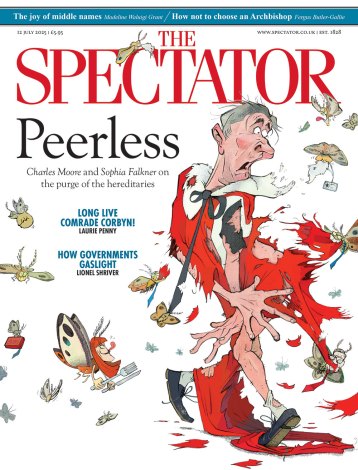The other evening my wife came home to find me watching re-runs of Steptoe and Son. The washing up had not been done, and everything was in a state of bedragglement (including Olga, the family dog). ‘How can you bear to watch that stuff? Steptoe’s got a face like a squeezed lemon. He’s perfectly horrible. I’ll go further: he’s perfectly revolting.’
How could my wife not like Steptoe? The series had been a hit from the moment it was launched in 1962 and drew audiences of over 20 million. Ray Galton and his co-writer Alan Simpson combined a seaside postcard sauciness with the cockney menace of Harold Pinter (only with shorter pauses). The series is, among other things, a meditation on human decrepitude and the frustrations of a father-son relationship.
Albert Steptoe and his son Harold are rag-and-bone men toiling in the Shepherd’s Bush area, who appear to loathe each other. With his foul temper and bad teeth, Albert relentlessly taunts his 37-year-old son for his dream of social self-improvement. (‘Saint Tropez? What’s wrong with Bognor?’) Every time Harold resolves to leave the junkyard for good, his father finds a way to thwart him. As Harold sees it, Albert is a conniving, filthy-minded malingerer (‘You dirty old man!’). Yet for all his wish to break free, Harold is doomed to be a nursemaid to his father, unmarried and likely to remain unmarried. What could be more sad?
In spite of the gloom, Steptoe and Son is grimly comic, and comedy hovers round the edges of the parent-child antagonism. The British public loved it. On election day in 1964, the story goes, Harold Wilson was so worried that Steptoe would distract Labour voters from the polling stations that he persuaded the BBC to take it off the box. (It had not occurred to Wilson that Tories might like the series, too.)
Harry H. Corbett brought his own good humour and charm to his role as the long-suffering son, while Wilfrid Brambell, a former Irish Times reporter, portrayed old man Steptoe’s geriatric discontent and malevolence with a ghastly realism. (His performance left its mark on the young Johnny Rotten, apparently, who modelled his strangulated Sex Pistols vocals and gargoyle-like gurnings on those of Albert.) To the British public, the Corbett-Brambell partnership was one made in heaven.
Off screen, according to the actress Susannah Corbett, the two men did not always get on.
In this biography of her father, Susannah hints at unresolved grievances. The Dublin-born Brambell emerges as a man embittered by a sense of personal failure and often drunk. Alcohol, it seems, was his salve for some unappeased yearning and inner hurt. In 1962, after a BBC cocktail party, Brambell was arrested for importuning on Shepherd’s Bush Green. If his Steptoe persona was aggressively heterosexual, in private Brambell was self-confessedly homosexual, as well as intermittently squiffy from slugs of gin. His behaviour deteriorated medievally during a Steptoe stage tour of the Antipodes in the mid-1970s, when he savagely kicked a woman fan in Australia. Later, during a live TV interview in New Zealand, he outdid himself: ‘I hope your fucking cathedral falls down,’ he snarled.
If Corbett himself often felt the lash of Brambell’s tongue, he did his best to ignore it. Trapped inside his Harold Steptoe caricature, he found it hard to move on as an actor. His appearance in Carry on Screaming! as detective Sidney Bung of Scotland Yard was as corny as a whoopee cushion. (With sublime schoolboy humour, the film features a live Egyptian mummy called Rubbatiti.) During the 1950s Corbett had been a classical stage actor in Joan Littlewood’s Theatre Workshop, and perhaps he hankered after his old, more serious status once the Steptoe series had finally come to an end in 1974. Instead, he appeared in a British blue movie called Hardcore, about the life and times of the suburban ‘glamour model’ Fiona Richmond. The old panto joke of ‘Where’s your career? It’s behind you!’ seems appropriate.
By any standards, Corbett’s was an unusual life. Born in Burma in 1925 to a British army sergeant, he was sent back to England at the age of three after his mother had died. Amid genteel poverty he was raised in Manchester by an aunt, and afterwards served with the Royal Marines in New Guinea where, according to his daughter, he killed two Japanese soldiers (one with a bayonet, the other with a commando knife). Unsurprisingly, he rarely spoke of what had happened in the war. His death in 1982 at the early age of 57 sent the nation into mourning. It seemed a friend had gone.
‘He was a fine actor and a finer man,’ says Susannah Corbett, who is to be congratulated on this moving and impeccably researched biography. Thank gawd for Steptoe and Son, say I (if not my wife).





Comments